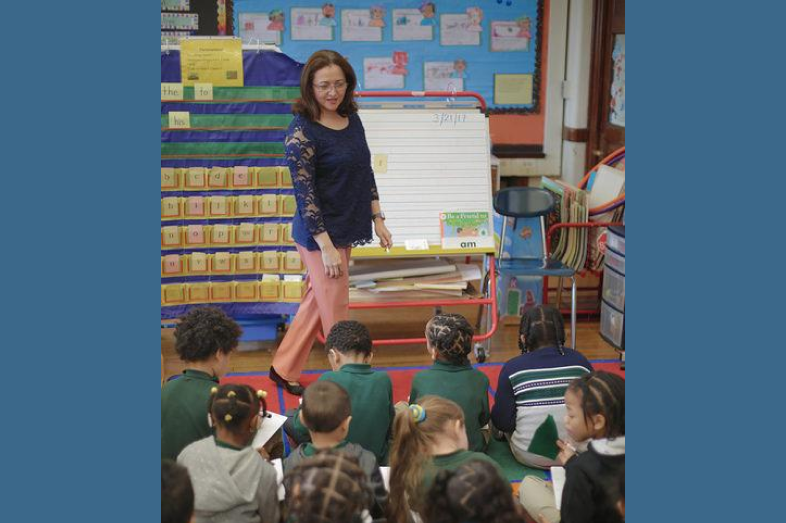

With enrollment in public prekindergarten programs at a record high, there is a growing emphasis on building stronger connections between children’s early learning experiences and the K-12 system. But bridging the divide between a sector that lacks a coherent structure and the more rigid K-12 system is a challenge rife with logistical as well as philosophical dilemmas.
Those dilemmas were discussed during a wide-ranging conversation with early education researchers and advocates at the annual conference of the Education Writers Association in Washington, D.C.
What makes integrating pre-K with the early elementary grades so difficult is the fragmented and unwieldy nature of the early childhood field.
With a multitude of early learning providers in any given community, some accredited or publicly funded and others not, gathering basic data and establishing lines of communication with public schools is a convoluted, and often neglected, task, said Rhian Evans Allvin, the CEO of the National Association for the Education of Young Children.
“You have these two very disparate systems and so much of the time families are left to their own devices to navigate the transition [to kindergarten],” Evans Allvin said during the EWA panel in late May.
She added: “It’s very rare that there’s a formal transition where the early learning program says, ‘Here, let me give you all the information we know about this child,’ or the kindergarten setting says, ‘Please let me have all the information.’ ”
From K-12 to P-12
One way to bridge that disconnect between early learning providers and the K-12 system is to formally integrate pre-K into public schools, essentially shifting from a K-12 school system to a P-12 system, said Jason Sachs, the director of early childhood education for Boston Public Schools.
“I would imagine 50 years from now [all] public schools will be serving 4-year-olds,” Sachs said.
Boston is seen as a national leader in the effort to improve coordination and alignment between pre-K providers and K-12 systems. The city has expanded the number of pre-K classrooms in its schools and partnered with community-based programs to provide curricular and instructional support to teachers in these settings.
Building a coherent, aligned, pre-K-through-third grade system is critical to sustaining the positive effects of pre-K on children’s academic and social development, advocates say. Some research suggests that, while students who attend pre-K programs enter kindergarten more academically and socially prepared, those gains tend to disappear over time — a point often cited by those skeptical of large-scale pre-K investments.
It’s important that pre-K not be considered an “inoculation” that magically sets children up for a lifetime of success, said Robert Pianta, the dean of the Curry School of Education at the University of Virginia. Instead, more information is needed to understand how best to sustain the gains children make in pre-K.
“We have very little knowledge about what K-3 environments look like that the kids go into,” Pianta said. “So we have this huge gap in knowledge about how skills and knowledge for kids accumulate over time and how one can use that information to build a system for pre-K-3.”
Investing in Teachers
One problem is that instruction in the early elementary grades is often designed in a way that is not developmentally appropriate for young children, Sachs said.
“Sitting where I sat for 11 years, I’d say public schools do not know how to educate young children,” he said. “There’s a lot of science about how young children learn, … and that’s not, frankly, how public schools are designed.”
Part of that has to do with the failure of higher education programs to adequately prepare teachers to teach in early childhood education, Sachs argued.
“I’m surprised at how little teachers are prepared to teach. If you think about the medical profession, you get four years of residency, you’re highly scrutinized in your practice. You just don’t get that in higher ed [for teachers],” Sachs said.
That comparison drew some pushback from Ruby Takanishi, a senior research fellow with the think tank New America and the author of the 2016 book, “First Things First! Creating the New American Primary School.”
“I think we have to be realistic and look the facts in the face,” Takanishi said. “The comparison with medical schools is, to me, disingenuous. When you look at what the public investment is in a doctor who goes to medical school, it probably is a million dollars. We don’t invest anything close to that in teachers.”
A Public or Private Good?
But according to Evans Allvin, debates about teacher qualifications, standards, and instruction obscure a larger, more fundamental question about the role of public policy in early learning.
“What underpins all of this is we fundamentally haven’t made a decision about whether early childhood education is a public or private good,” she said. “When you arrive in a neighborhood, whether it’s a really atrocious school or a great school, you know you get to go to school.”
Yet that’s not the case for pre-K, since the availability and affordability of programs varies significantly from place to place, Evans Allvin said.
Illustrated throughout the discussion was the increasing recognition that children’s earliest learning experiences are essential. But how that recognition translates into policy action and what it means for K-12 systems are issues that cities and states expanding pre-K will likely continue to grapple with.
“We’ve generated the knowledge of how children have these amazing capacities to learn and that inequalities begin very early in life,” Takanishi said. “But what does it mean for the future?”


